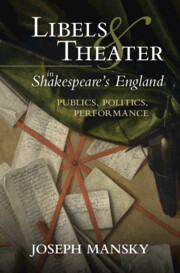Book contents
- Libels and Theater in Shakespeare’s England
- Libels and Theater in Shakespeare’s England
- Copyright page
- Dedication
- Contents
- Acknowledgments
- Abbreviations
- Introduction Seeds of Sedition
- Part I The Scene of Libel
- Part II Libels on the Elizabethan Stage
- Epilogue Staging Libel in Early Stuart England
- Bibliography
- Index
Epilogue - Staging Libel in Early Stuart England
Published online by Cambridge University Press: 05 October 2023
- Libels and Theater in Shakespeare’s England
- Libels and Theater in Shakespeare’s England
- Copyright page
- Dedication
- Contents
- Acknowledgments
- Abbreviations
- Introduction Seeds of Sedition
- Part I The Scene of Libel
- Part II Libels on the Elizabethan Stage
- Epilogue Staging Libel in Early Stuart England
- Bibliography
- Index
Summary
The epilogue situates the foregoing chapters in a longer theater history, tracing two early Stuart scenes of libel – in the anonymous Nobody and Somebody (c.1605) and Philip Massinger’s The Roman Actor (1626) – to their late Elizabethan roots. In Nobody and Somebody, the titular characters reenact in a comic vein Heywood’s story of Jane Shore and Richard III from Edward IV. At once a folk hero and a figure for libel, Nobody plays on his constitutive anonymity to affiliate himself with the same seditious, defamatory talk of which he is falsely accused. The Roman Actor likewise revises the paradigm of libel formulated by its dramatic predecessor, in this case Jonson’s Poetaster. In the play’s metatheatrical opening scenes, the actor Paris rehearses Jonsonian arguments to vindicate himself from accusations of libel leveled by the corrupt tribune and spy, Aretinus. Yet the rest of Massinger’s play belies Paris’s defense of playing, laying bare the unresolved ironies at the heart of Jonson’s satirical project. Finally, the epilogue returns in closing to the constitutive tensions – between protest and threat, free speech and false news – that animated the early modern public sphere.
Keywords
- Type
- Chapter
- Information
- Libels and Theater in Shakespeare's EnglandPublics, Politics, Performance, pp. 204 - 213Publisher: Cambridge University PressPrint publication year: 2023



